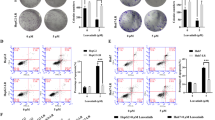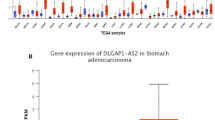Abstract
Purpose
The finding of mTOR overactivation in patients affected by pancreatic neuroendocrine tumors (Pa-NETs) led to their treatment with the mTOR inhibitor everolimus. Unfortunately, the efficacy of everolimus is restricted by the occurrence of resistance. The mechanisms leading to Pa-NETs’ progression and resistance are not well understood. Notably, chronic inflammation is implicated in NET development. NF-kB is involved in inflammation and drug resistance mechanisms through the activation of several mediators, including STAT3. In this respect, NF-κB and STAT3 interaction is implicated in the crosstalk between inflammatory and tumor cells.
Methods
We investigated the expression of NF-kB in different Pa-NETs by RT-qPCR and immunohistochemistry. Then, we studied the role of NF-κB and STAT3 interplay in QGP-1 cells. Subsequently, we assessed the impact of NF-κB and STAT3 inhibitors in QGP-1 cell proliferation and spheroids growth. Finally, we evaluated the implication of the NF-kB pathway in everolimus-resistant Pa-NET cells.
Results
We found that the increased NF-kB expression correlates with a higher grade in Pa-NETs. The activation of the STAT3 pathway induced by TNFα is mediated by NF-kB p65. NF-kB p65 and STAT3 inhibitors decrease QGP-1 viability, spheroids growth, and Pa-NETs cell proliferation. These effects are maintained in everolimus-resistant QGP-1R cells. Interestingly, we found that NF-kB, STAT3, IL-8, and SOCS3 are overexpressed in QGP-1R compared to QGP-1.
Conclusion
Since the NF-kB pathway is implicated in Pa-NETs’ progression and resistance to everolimus, these data could explain the potential use of NF-kB as a novel therapeutic target in Pa-NET patients.










Similar content being viewed by others
Data availability
The data that support the findings of this study are available upon reasonable request in Zenodo repository (https://zenodo.org/deposit/8411582).
References
Dasari A, Shen C, Halperin D et al (2017) Trends in the incidence, prevalence, and survival outcomes in patients with neuroendocrine tumors in the United States. JAMA Oncol 3:1335–1342. https://doi.org/10.1001/jamaoncol.2017.0589
Nagtegaal ID, Odze RD, Klimstra D et al (2020) The 2019 WHO classification of tumours of the digestive system. Histopathology 76:182–188. https://doi.org/10.1111/his.13975
Pavel M, O’Toole D, Costa F et al (2016) ENETS consensus guidelines update for the management of distant metastatic disease of intestinal, pancreatic, bronchial neuroendocrine neoplasms (NEN) and NEN of unknown primary site. Neuroendocrinology 103:172–185
Missiaglia E, Dalai I, Barbi S et al (2010) Pancreatic endocrine tumors: expression profiling evidences a role for AKT-mTOR pathway. J Clin Oncol 28:245–255. https://doi.org/10.1200/JCO.2008.21.5988
Zhou CF, Ji J, Yuan F et al (2011) mTOR activation in well differentiated pancreatic neuroendocrine tumors: a retrospective study on 34 cases. Hepatogastroenterology 58:2140–2143. https://doi.org/10.5754/hge11212
Yao JC, Shah MH, Ito T et al (2011) Everolimus for advanced pancreatic neuroendocrine tumors for the RAD001 in advanced neuroendocrine tumors, third trial (RADIANT-3) study group. N Engl J Med 364:514–523. https://doi.org/10.1056/NEJMoa1009290
Yao JJC, Fazio N, Singh S et al (2016) Everolimus for the treatment of advanced, non-functional neuroendocrine tumours of the lung or gastrointestinal tract (RADIANT-4): a randomised, placebo-controlled, phase 3 study. Lancet 387:968–977. https://doi.org/10.1016/S0140-6736(15)00817-X
Vandamme T, Beyens M, De Beeck KO et al (2016) Long-term acquired everolimus resistance in pancreatic neuroendocrine tumours can be overcome with novel PI3K-AKT-mTOR inhibitors. Br J Cancer 114:650–658. https://doi.org/10.1038/bjc.2016.25
Berkovic MC, Cacev T, Ivkovic TC et al (2014) New insights into the role of chronic inflammation and cytokines in the etiopathogenesis of gastroenteropancreatic neuroendocrine tumors. Neuroendocrinology 99:75–84. https://doi.org/10.1159/000362339
Vitale G, Carra S, Ferraù F et al (2020) Gastroenteropancreatic neuroendocrine neoplasms and inflammation: a complex cross-talk with relevant clinical implications. Crit Rev Oncol Hematol 146:102840
Vitale G, Dicitore A, Barrea L et al (2021) From microbiota toward gastro-enteropancreatic neuroendocrine neoplasms: are we on the highway to hell? Rev Endocr Metab Disord 22:511–525. https://doi.org/10.1007/s11154-020-09589-y
Temiz-resitoglu M, Sinem D, Cecen P (2017) Activation of mTOR/IκB-α/NF-κB pathway contributes to LPS-induced hypotension and inflammation in rats. Eur J Pharmacol 802:7–19. https://doi.org/10.1016/j.ejphar.2017.02.034
Kunsch C, Lang RK, Rosen CA, Shannon MF (1994) Synergistic transcriptional activation of the IL-8 gene by NF-kappa B p65 (RelA) and NF-IL-6. J Immunol 153:153–164. https://doi.org/10.4049/jimmunol.153.1.153
Hussain F, Wang J, Ahmed R et al (2010) Cytokine The expression of IL-8 and IL-8 receptors in pancreatic adenocarcinomas and pancreatic neuroendocrine tumours. Cytokine 49:134–140. https://doi.org/10.1016/j.cyto.2009.11.010
Braeuer SJ, Büneker C, Mohr A, Zwacka RM (2006) Constitutively activated nuclear factor-κB, but not induced NF-κB, leads to TRAIL resistance by up-regulation of X-linked inhibitor of apoptosis protein in human cancer cells. Mol Cancer Res. https://doi.org/10.1158/1541-7786.MCR-05-0231
Taniguchi K, Karin M (2018) REVIEWS NF-κB, inflammation, immunity and cancer : coming of age. Nat Publ Gr 18:309–324. https://doi.org/10.1038/nri.2017.142
Lopez-aguiar AG, Postlewait LM, Ethun CG et al (2019) STAT3 inhibition for gastroenteropancreatic neuroendocrine tumors : potential for a new therapeutic target? J Gastrointest Surg 24:1138–1148
Ghosh S, Karin M (2002) Missing pieces in the NF-κB puzzle. Cell 109:S81–S96
Bassères DS, Baldwin AS (2006) Nuclear factor-κB and inhibitor of κB kinase pathways in oncogenic initiation and progression. Oncogene 25:6817–6830
Gilmore TD (2003) The Re1/NF-kappa B/I kappa B signal transduction pathway and cancer. Cancer Treat Res 115:241–265
Grivennikov SI, Karin M (2010) Dangerous liaisons: STAT3 and NF-κB collaboration and crosstalk in cancer. Cytokine Growth Factor Rev 21:11–19. https://doi.org/10.1016/j.cytogfr.2009.11.005
Kubo M, Hanada T, Yoshimura A (2003) Suppressors of cytokine signaling and immunity. Nat Immunol 4:1169–1176
Bromberg JF, Wrzeszczynska MH, Devgan G et al (1999) Stat3 as an oncogene. Cell 98:295–303. https://doi.org/10.1016/S0092-8674(00)81959-5
Yu H, Jove R (2004) The stats of cancer—new molecular targets come of age. Nat Rev Cancer 4:97–105
Sansone P, Storci G, Tavolari S et al (2007) IL-6 triggers malignant features in mammospheres from human ductal breast carcinoma and normal mammary gland. J Clin Invest 117:3988–4002. https://doi.org/10.1172/JCI32533
Yin YZ, Wang YC (2006) Analysis of behaviour of steel beams with web openings at elevated temperatures. Steel Compos Struct 6:15–31. https://doi.org/10.1186/1476-4598-5-15
Kesanakurti D, Chetty C, Rajasekhar Maddirela D et al (2013) Essential role of cooperative NF-κB and Stat3 recruitment to ICAM-1 intronic consensus elements in the regulation of radiation-induced invasion and migration in glioma. Oncogene 32:5144–5155. https://doi.org/10.1038/onc.2012.546
Fan Y, Mao R, Yang J (2013) NF- κ B and STAT3 signaling pathways collaboratively link inflammation to cancer. Protein Cell 4:176–185. https://doi.org/10.1007/s13238-013-2084-3
Vitali E, Boemi I, Piccini S et al (2020) A novel insight into the anticancer mechanism of metformin in pancreatic neuroendocrine tumor cells. Mol Cell Endocrinol 509:110803. https://doi.org/10.1016/j.mce.2020.110803
Vitali E, Cambiaghi V, Zerbi A et al (2016) Filamin-a is required to mediate SST2 effects in pancreatic neuroendocrine tumours. Endocr Relat Cancer 23:181–190. https://doi.org/10.1530/ERC-15-0358
Vitali E, Boemi I, Rosso L et al (2017) FLNA is implicated in pulmonary neuroendocrine tumors aggressiveness and progression. Oncotarget 8:77330–77340. https://doi.org/10.18632/oncotarget.20473
Vitali E, Boemi I, Tarantola G et al (2020) Metformin and everolimus: a promising combination for neuroendocrine tumors treatment. Cancers (Basel) 12:1–18. https://doi.org/10.3390/cancers12082143
Lania AG, Mantovani G, Ferrero S et al (2004) Proliferation of transformed somatotroph cells related to low or absent expression of protein kinase A regulatory subunit 1A protein. Cancer Res 64:9193–9198. https://doi.org/10.1158/0008-5472.CAN-04-1847
Herrera-Martínez AD, van den Dungen R, Dogan-Oruc F et al (2019) Effects of novel somatostatin-dopamine chimeric drugs in 2D and 3D cell culture models of neuroendocrine tumors. Endocr Relat Cancer 26:585–599. https://doi.org/10.1530/ERC-19-0086
Raj N, Reidy-Lagunes D (2016) Systemic therapies for advanced pancreatic neuroendocrine tumors. Hematol Oncol Clin North Am 30:119–133
Lee L, Ito T, Jensen RT (2018) Everolimus in the treatment of neuroendocrine tumors: efficacy, side-effects, resistance, and factors affecting its place in the treatment sequence. Expert Opin Pharmacother 19:909–928. https://doi.org/10.1080/14656566.2018.1476492
O’Reilly KE, Rojo F, She QB et al (2006) mTOR inhibition induces upstream receptor tyrosine kinase signaling and activates Akt. Cancer Res 66:1500–1508. https://doi.org/10.1158/0008-5472.CAN-05-2925
Mahečić DH, Berković MC, Zjačić-Rotkvić V et al (2020) Inflammation-related cytokines and their roles in gastroenteropancreatic neuroendocrine neoplasms. Bosn J Basic Med Sci 20:445–450. https://doi.org/10.17305/bjbms.2020.4471
Waugh DJJ, Wilson C (2008) The interleukin-8 pathway in cancer. Clin Cancer Res 14:6735–6741
Elliott CL, Allport VC, Loudon JAZ et al (2001) Nuclear factor-kappa B is essential for up-regulation of interleukin-8 expression in human amnion and cervical epithelial cells. Mol Hum Reprod 7:787–790. https://doi.org/10.1093/molehr/7.8.787
Taniguchi K, Karin M (2018) NF-B, inflammation, immunity and cancer: coming of age. Nat Rev Immunol 18:309–324
Bai D, Ueno L, Vogt PK (2009) Akt-mediated regulation of NFκB and the essentialness of NFκB for the oncogenicity of PI3K and Akt. Int J Cancer 125:2863–2870. https://doi.org/10.1002/ijc.24748
El Jamal SM, Yaseen AA, Alatassi H et al (2017) Strong NFkB expression is associated with high-grade dysplasia in Barrett’s esophagus. Appl Immunohistochem Mol Morphol 25:329–333. https://doi.org/10.1097/PAI.0000000000000359
Sarkar DK, Jana D, Patil PS et al (2013) Role of NF-κB as a prognostic marker in breast cancer: a pilot study in Indian patients. Indian J Surg Oncol 4:242–247. https://doi.org/10.1007/s13193-013-0234-y
Annunziata CM, Stavnes HT, Kleinberg L et al (2010) Nuclear factor κB transcription factors are coexpressed and convey a poor outcome in ovarian cancer. Cancer. https://doi.org/10.1002/cncr.25190
Inoue S, Ide H, Mizushima T et al (2018) Nuclear factor-kb promotes urothelial tumorigenesis and cancer progression via cooperation with androgen receptor signaling. Mol Cancer Ther 17:1303–1314. https://doi.org/10.1158/1535-7163.MCT-17-0786
Bakshi HA, Quinn GA, Nasef MM et al (2022) Crocin inhibits angiogenesis and metastasis in colon cancer via TNF-α/NF-kB/VEGF pathways. Cells 14:1–15. https://doi.org/10.3390/cells11091502
Transl S, Author M, August PMC, et al (2022) CECR2 drives breast cancer metastasis by promoting NF-κB signaling and macrophage-mediated immune suppression HHS public access. 14:1–33. https://doi.org/10.5281/zenodo.5797228
Fan Y, Mao R, Yang J (2013) NF-κB and STAT3 signaling pathways collaboratively link inflammation to cancer. Protein Cell 4:176–185
Burger M, Hartmann T, Burger JA, Schraufstatter I (2005) KSHV-GPCR and CXCR2 transforming capacity and angiogenic responses are mediated through a JAK2-STAT3-dependent pathway. Oncogene 24:2067–2075. https://doi.org/10.1038/sj.onc.1208442
Mcfarland BC, Hong SW, Rajbhandari R et al (2013) NF-κB-induced IL-6 ensures STAT3 activation and tumor aggressiveness in glioblastoma. PLoS ONE. https://doi.org/10.1371/journal.pone.0078728
Chen H, Bian A, Yang FL et al (2021) Targeting STAT3 by a small molecule suppresses pancreatic cancer progression. Oncogene. https://doi.org/10.1038/s41388-020-01626-z
Friedrich J, Seidel C, Ebner R, Kunz-Schughart LA (2009) Spheroid-based drug screen: considerations and practical approach. Nat Protoc 4:309–324. https://doi.org/10.1038/nprot.2008.226
Khongthong P, Roseweir AK, Edwards J (2019) The NF-KB pathway and endocrine therapy resistance in breast cancer. Endocr Relat Cancer 26:R369–R380. https://doi.org/10.1530/ERC-19-0087
Sciammarella C, Luce A, Riccardi F et al (2020) Lanreotide induces cytokine modulation in intestinal neuroendocrine tumors and overcomes resistance to everolimus. Front Oncol. https://doi.org/10.3389/fonc.2020.01047
Funding
This work has been supported by PRIN 2022CZR88M and P20227KXJK.
Author information
Authors and Affiliations
Corresponding author
Ethics declarations
Conflicts of interest
The authors have no conflicts of interest to declare.
Ethical approval
This research was performed in accordance with the ethical standards of the Independent Ethics Committee of Istituto Clinico Humanitas—IRCCS, Rozzano (Milan) and with the 1964 Helsinki Declaration.
Informed consent
Informed consent was obtained from all individual participants.
Additional information
Publisher's Note
Springer Nature remains neutral with regard to jurisdictional claims in published maps and institutional affiliations.
Rights and permissions
Springer Nature or its licensor (e.g. a society or other partner) holds exclusive rights to this article under a publishing agreement with the author(s) or other rightsholder(s); author self-archiving of the accepted manuscript version of this article is solely governed by the terms of such publishing agreement and applicable law.
About this article
Cite this article
Vitali, E., Valente, G., Panzardi, A. et al. Pancreatic neuroendocrine tumor progression and resistance to everolimus: the crucial role of NF-kB and STAT3 interplay. J Endocrinol Invest 47, 1101–1117 (2024). https://doi.org/10.1007/s40618-023-02221-1
Received:
Accepted:
Published:
Issue Date:
DOI: https://doi.org/10.1007/s40618-023-02221-1




